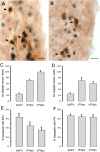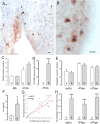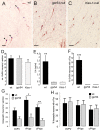Kisspeptin-GPR54 signaling is essential for preovulatory gonadotropin-releasing hormone neuron activation and the luteinizing hormone surge
- PMID: 18753370
- PMCID: PMC6670827
- DOI: 10.1523/JNEUROSCI.1775-08.2008
Kisspeptin-GPR54 signaling is essential for preovulatory gonadotropin-releasing hormone neuron activation and the luteinizing hormone surge
Abstract
Kisspeptin and its receptor GPR54 have recently been identified as key signaling partners in the neural control of fertility in animal models and humans. The gonadotropin-releasing hormone (GnRH) neurons represent the final output neurons of the neural network controlling fertility and are suspected to be the primary locus of kisspeptin-GPR54 signaling. Using mouse models, the present study addressed whether kisspeptin and GPR54 have a key role in the activation of GnRH neurons to generate the luteinizing hormone (LH) surge responsible for ovulation. Dual-label immunocytochemistry experiments showed that 40-60% of kisspeptin neurons in the rostral periventricular area of the third ventricle (RP3V) expressed estrogen receptor alpha and progesterone receptors. Using an ovariectomized, gonadal steroid-replacement regimen, which reliably generates an LH surge, approximately 30% of RP3V kisspeptin neurons were found to express c-FOS in surging mice compared with 0% in nonsurging controls. A strong correlation was found between the percentage of c-FOS-positive kisspeptin neurons and the percentage of c-FOS-positive GnRH neurons. To evaluate whether kisspeptin and/or GPR54 were essential for GnRH neuron activation and the LH surge, Gpr54- and Kiss1-null mice were examined. Whereas wild-type littermates all exhibited LH surges and c-FOS in approximately 50% of their GnRH neurons, none of the mutant mice from either line showed an LH surge or any GnRH neurons with c-FOS. These observations provide the first evidence that kisspeptin-GPR54 signaling is essential for GnRH neuron activation that initiates ovulation. This broadens considerably the potential roles and therapeutic possibilities for kisspeptin and GPR54 in fertility regulation.
Figures



References
-
- Adachi S, Yamada S, Takatsu Y, Matsui H, Kinoshita M, Takase K, Sugiura H, Ohtaki T, Matsumoto H, Uenoyama Y, Tsukamura H, Inoue K, Maeda K. Involvement of anteroventral periventricular metastin/kisspeptin neurons in estrogen positive feedback action on luteinizing hormone release in female rats. J Reprod Dev. 2007;53:367–378. - PubMed
-
- Bronson FH. The regulation of luteinizing hormone secretion by estrogen: relationships among negative feedback, surge potential, and male stimulation in juvenile, peripubertal, and adult female mice. Endocrinology. 1981;108:506–516. - PubMed
-
- Chappell PE, Levine JE. Stimulation of gonadotropin-releasing hormone surges by estrogen. I. Role of hypothalamic progesterone receptors. Endocrinology. 2000;141:1477–1485. - PubMed
-
- Clarkson J, Herbison AE. Development of GABA and glutamate signaling at the GnRH neuron in relation to puberty. Mol Cell Endocrinol. 2006a;254—255:32–38. - PubMed
Publication types
MeSH terms
Substances
Grants and funding
LinkOut - more resources
Full Text Sources
Other Literature Sources
Molecular Biology Databases
